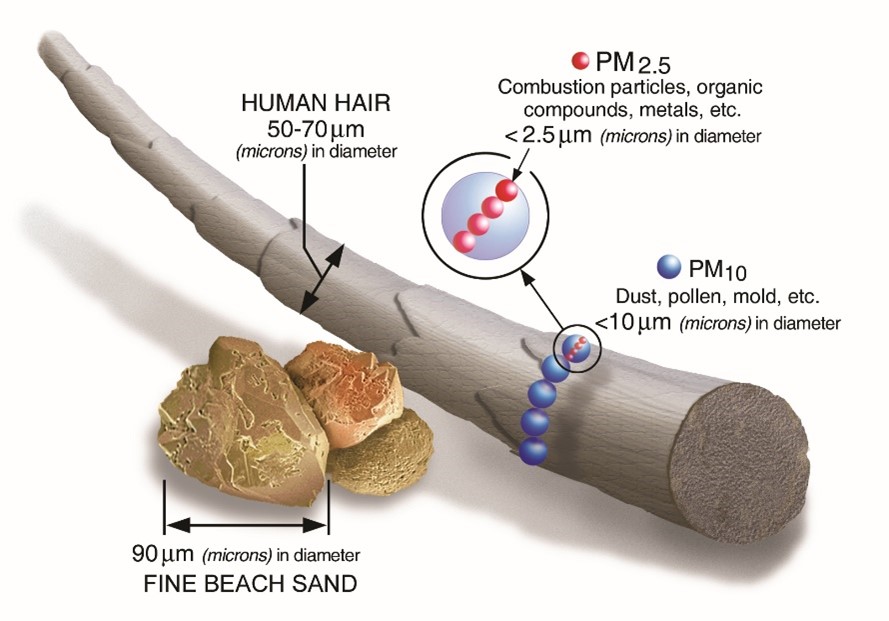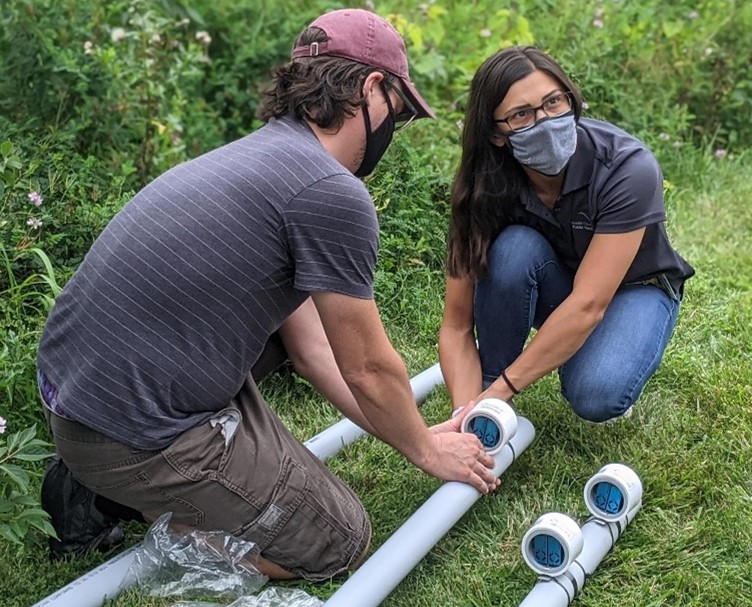Moderate concentrations of ozone and particle pollution (soot) in the air make it more difficult for older adults, young children and those who suffer from heart disease and respiratory problems such as asthma, bronchitis and emphysema to breathe. When inhaled, ozone and particle pollution inflame the lining of our lungs, causing coughing, wheezing and serious asthma attacks in asthma sufferers. Also, numerous studies have linked particle pollution to various forms of heart disease and even premature death. High concentrations of ozone and soot can make breathing difficult for healthy adults, too.
Neighborhood Air Quality Monitoring Project
Establishing an Air Quality Monitoring Network for Inform Local Strategies
Project Background
FCPH and Mid-Ohio Regional Planning Commission (MORPC) are partnering to establish an air quality monitoring network that will measure air pollution, neighborhood by neighborhood, in Franklin County. By gathering more data at the local level, this project will help guide the strategies that go into making the region's air healthier and easier to breathe.
What will this project monitor?
Particle air pollution — also called particulate matter (PM). Particle air pollution is made up of tiny pieces of matter, many of which are much smaller than a grain of sand. These particles may include:
- dust
- dirt
- soot
- smoke
- drops of liquid
Some particles are big enough (or appear dark enough) to see — for example, you can often see smoke in the air. Others are so small that you can’t see them in the air.

Photo courtesy of the EPA.
Air Quality and Health
Particle air pollution can affect anyone, but it bothers some people more than others. Particle air pollution is so small that when you breathe it in, it can pass through your lungs and into your bloodstream, causing inflammation in your body. It has been linked to heart and lung diseases – and many others – because of the inflammation it causes. Exposure to particle pollution has also been linked to worse COVID-19 outcomes for people who contracted COVID-19.
People most likely to experience health effects caused by particle pollution include:
- People with heart or lung diseases (for example, asthma)
- Older adults
- Babies and children
Read more about the health impacts of PM. The (MORPC) monitors the air quality index daily and will issue Air Quality Alerts when there is a potential for high pollution levels.
How will this project monitor for particle air pollution?
The air quality monitors we are using are called PurpleAir monitors. Installing air quality monitors in different neighborhoods will help us better understand existing environmental disparities and enable organizations to establish programs that improve the air quality in the locations that most need it. A PurpleAir monitor is easy to install in most locations, allowing useful data to be collected at the neighborhood level.

Where will we monitor for particle pollution?
We are using data to prioritize where the monitors are located across throughout the Franklin County. This includes sociodemographic data on the percentage of poverty and minorities in various locations, as well as the number of children under the age of 5 and adults who are 65+. We are also using public health data on asthma and COVID-19 rates in each ZIP code. The ZIP codes are then ranked according to their indicators of the potential impact of air pollution exposure on the local community.
Currently targeted zip codes:
43203, 43211, 43222, 43227, 43232, 43204, 43213, 43214, 43212, 43207.
Purple Air Real-Time Data Map
Take a real-time look at our network of monitors so far by visiting, https://www.morpc.org/program-service/neighborhood-air-quality-monitoring-program/
How can I be involved?
You or your business or organization can keep a monitor on site! Site requests will be reviewed and pursued based on the project needs.
Requirements for having a monitor are include:
- an exterior surface to which the monitor can be attached by zip-tie or screws
- an accessible electrical outlet
- an accessible and reliable Wi-Fi network.
For more information:

Jennie McAdams
Sustainability Supervisor
Franklin County Public Health
JennieMcAdams@franklincountyohio.gov
Layla Abraham
Environmental Health Educator
Franklin County Public Health
LaylaAbraham@franklincountyohio.gov

Brandi Whetstone, LEED Green Associate
Associate Director, Sustainability
Mid-Ohio Regional Planning Commission
bwhetstone@morpc.org
Air Quality Index
The Mid-Ohio Regional Planning Commission (MORPC) monitors the air quality index daily and will issue Air Quality Alerts to warn the public when air pollution levels are high enough to cause unhealthy conditions especially for children, adults who are active outdoors, people with heart or lung diseases (such as asthma and COPD) and older adults. Air Quality Alerts are most often issued on very hot and humid days. These conditions could also lead to other health risks such as heat exhaustion or heat stroke. Read more heat safety tips and information.
To receive alerts, follow MORPC on Facebook or Twitter, sign up for MORPC's EnviroFlash emails or call the Central Ohio Air Quality Hotline at 1-888-666-1009.
Open Burning
 Open burning is any set outdoor fire that does not vent to a chimney or stack. Some studies indicate that even small camp fires burning clean wood can emit harmful chemicals. Burning "unclean" materials can be even more hazardous. For example, when you burn refuse in burn barrels or open piles, the potential cost to your health, your home, your neighbors and your environment far exceeds the price of adequate collection services. Protect yourself, your neighbors and your wallet by knowing what you can burn and where. For more information on open burning, visit the Ohio Environmental Protection Agency (EPA). If you have any questions, or would like to report a suspected open burning incident, contact the Ohio EPA District Office or MORPC.
Open burning is any set outdoor fire that does not vent to a chimney or stack. Some studies indicate that even small camp fires burning clean wood can emit harmful chemicals. Burning "unclean" materials can be even more hazardous. For example, when you burn refuse in burn barrels or open piles, the potential cost to your health, your home, your neighbors and your environment far exceeds the price of adequate collection services. Protect yourself, your neighbors and your wallet by knowing what you can burn and where. For more information on open burning, visit the Ohio Environmental Protection Agency (EPA). If you have any questions, or would like to report a suspected open burning incident, contact the Ohio EPA District Office or MORPC.
